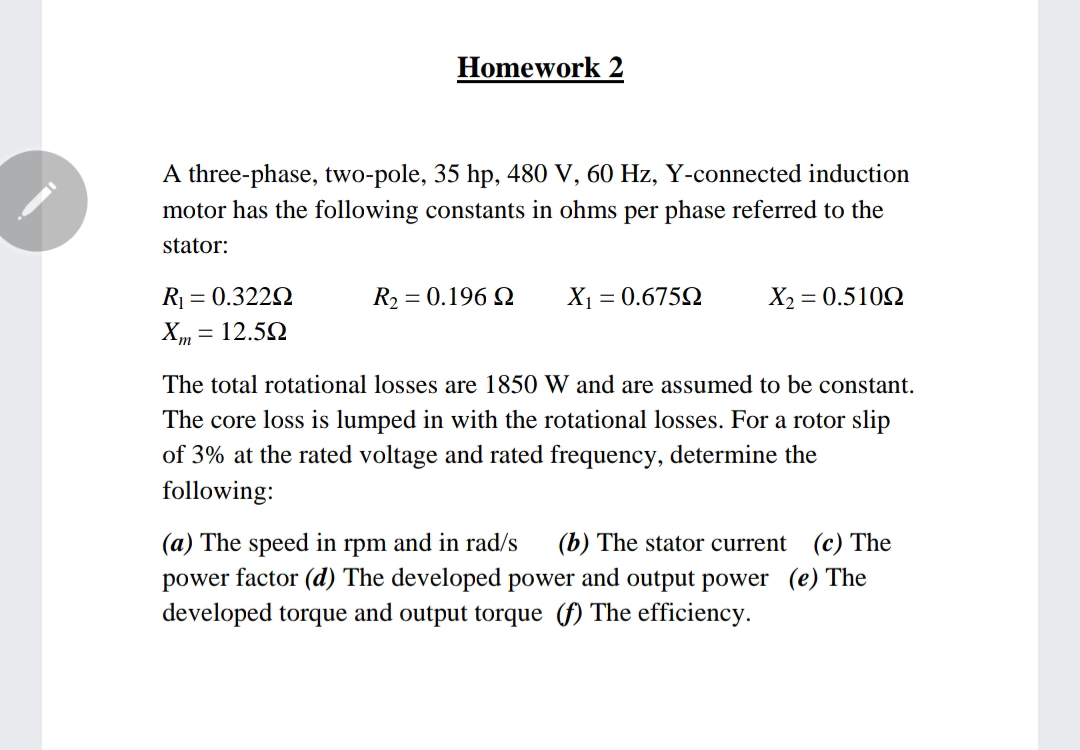Homework 2 A three-phase, two-pole, 35 hp, 480 V, 60 Hz, Y-connected induction motor has the following constants in ohms per phase referred to the stator: R = 0.322N R2 = 0.196 Q X1 = 0.6752 X2 = 0.510N Xm = 12.52 The total rotational losses are 1850 W and are assumed to be constant. The core loss is lumped in with the rotational losses. For a rotor slip of 3% at the rated voltage and rated frequency, determine the following: (b) The stator current (c) The (a) The speed in rpm and in rad/s power factor (d) The developed power and output power (e) The developed torque and output torque (f) The efficiency.
Homework 2 A three-phase, two-pole, 35 hp, 480 V, 60 Hz, Y-connected induction motor has the following constants in ohms per phase referred to the stator: R = 0.322N R2 = 0.196 Q X1 = 0.6752 X2 = 0.510N Xm = 12.52 The total rotational losses are 1850 W and are assumed to be constant. The core loss is lumped in with the rotational losses. For a rotor slip of 3% at the rated voltage and rated frequency, determine the following: (b) The stator current (c) The (a) The speed in rpm and in rad/s power factor (d) The developed power and output power (e) The developed torque and output torque (f) The efficiency.
Introductory Circuit Analysis (13th Edition)
13th Edition
ISBN:9780133923605
Author:Robert L. Boylestad
Publisher:Robert L. Boylestad
Chapter1: Introduction
Section: Chapter Questions
Problem 1P: Visit your local library (at school or home) and describe the extent to which it provides literature...
Related questions
Question

Transcribed Image Text:Homework 2
A three-phase, two-pole, 35 hp, 480 V, 60 Hz, Y-connected induction
motor has the following constants in ohms per phase referred to the
stator:
R = 0.322N
R2 = 0.196 Q
X1 = 0.675Q
X2 = 0.5102
Xm = 12.52
The total rotational losses are 1850 W and are assumed to be constant.
The core loss is lumped in with the rotational losses. For a rotor slip
of 3% at the rated voltage and rated frequency, determine the
following:
(a) The speed in rpm and in rad/s
(b) The stator current
(c) The
power factor (d) The developed power and output power (e) The
developed torque and output torque (f) The efficiency.
Expert Solution
This question has been solved!
Explore an expertly crafted, step-by-step solution for a thorough understanding of key concepts.
Step by step
Solved in 2 steps with 4 images

Knowledge Booster
Learn more about
Need a deep-dive on the concept behind this application? Look no further. Learn more about this topic, electrical-engineering and related others by exploring similar questions and additional content below.Recommended textbooks for you

Introductory Circuit Analysis (13th Edition)
Electrical Engineering
ISBN:
9780133923605
Author:
Robert L. Boylestad
Publisher:
PEARSON

Delmar's Standard Textbook Of Electricity
Electrical Engineering
ISBN:
9781337900348
Author:
Stephen L. Herman
Publisher:
Cengage Learning

Programmable Logic Controllers
Electrical Engineering
ISBN:
9780073373843
Author:
Frank D. Petruzella
Publisher:
McGraw-Hill Education

Introductory Circuit Analysis (13th Edition)
Electrical Engineering
ISBN:
9780133923605
Author:
Robert L. Boylestad
Publisher:
PEARSON

Delmar's Standard Textbook Of Electricity
Electrical Engineering
ISBN:
9781337900348
Author:
Stephen L. Herman
Publisher:
Cengage Learning

Programmable Logic Controllers
Electrical Engineering
ISBN:
9780073373843
Author:
Frank D. Petruzella
Publisher:
McGraw-Hill Education

Fundamentals of Electric Circuits
Electrical Engineering
ISBN:
9780078028229
Author:
Charles K Alexander, Matthew Sadiku
Publisher:
McGraw-Hill Education

Electric Circuits. (11th Edition)
Electrical Engineering
ISBN:
9780134746968
Author:
James W. Nilsson, Susan Riedel
Publisher:
PEARSON

Engineering Electromagnetics
Electrical Engineering
ISBN:
9780078028151
Author:
Hayt, William H. (william Hart), Jr, BUCK, John A.
Publisher:
Mcgraw-hill Education,